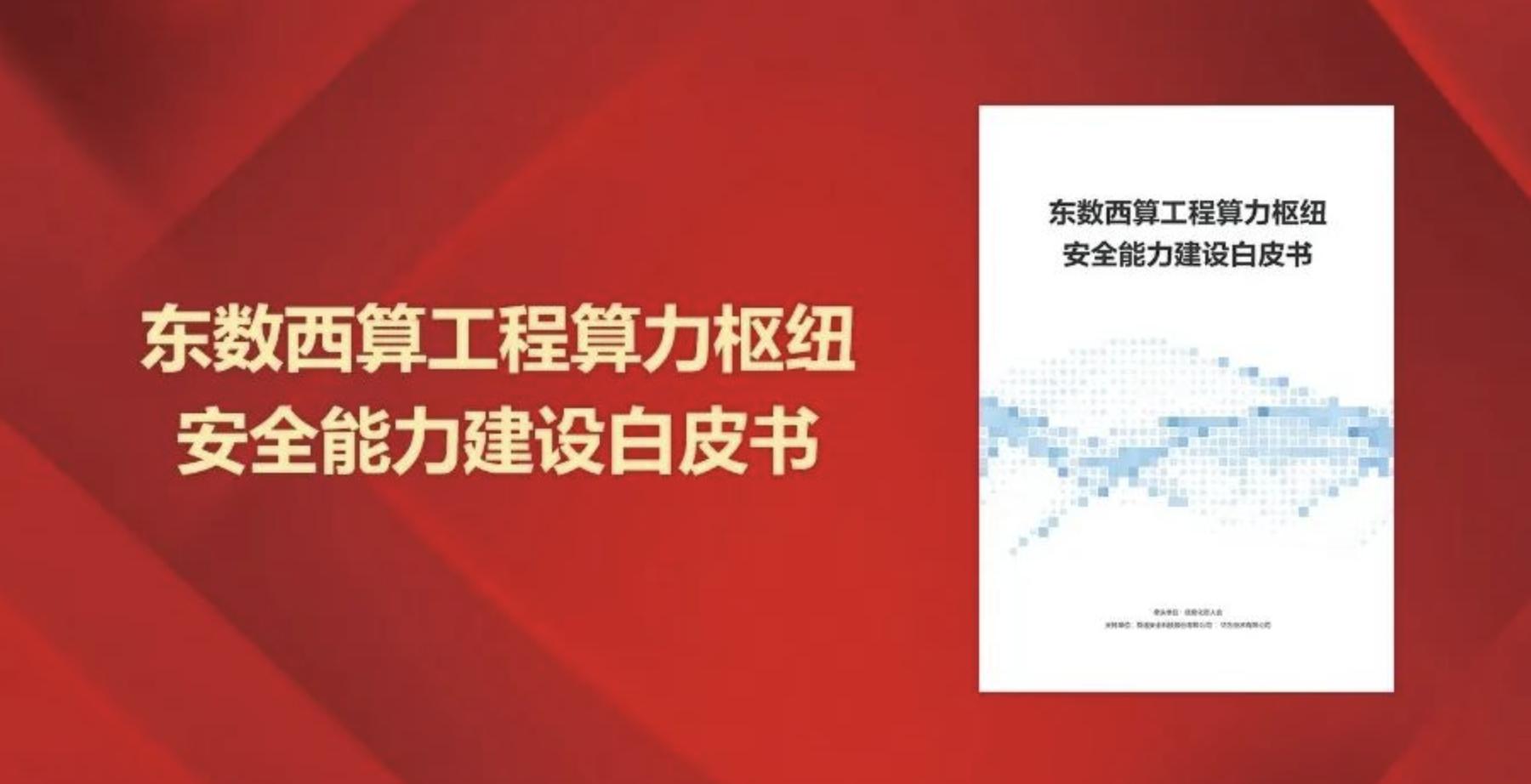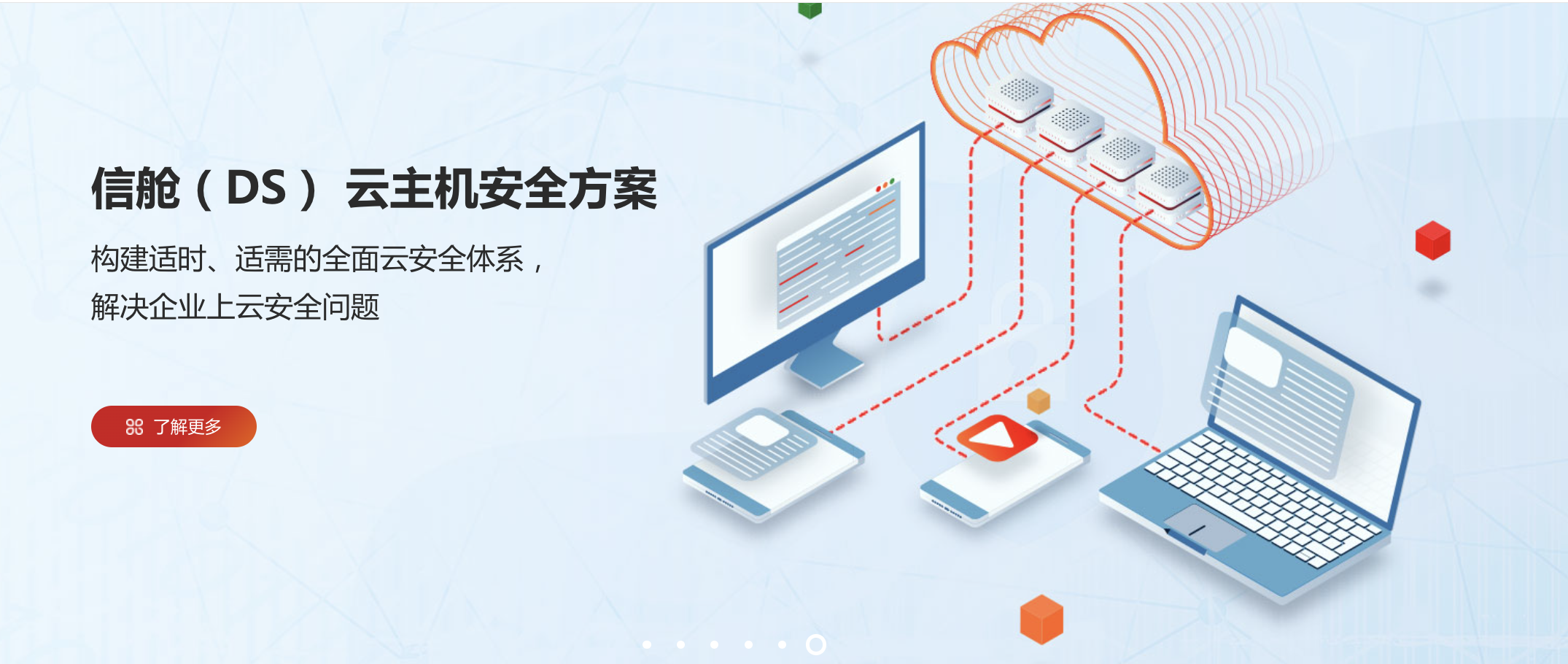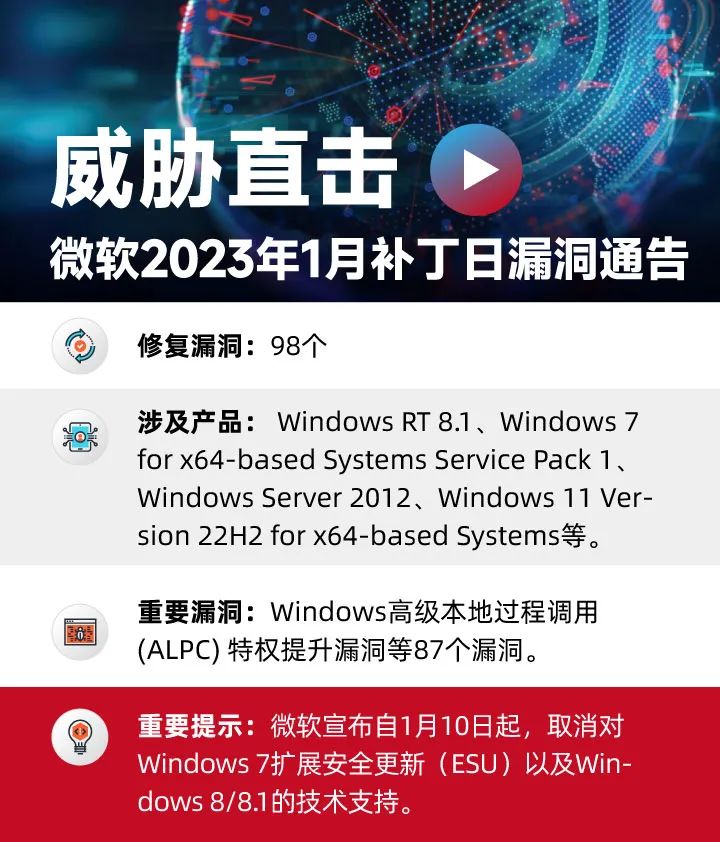近日,亞信安全CERT監(jiān)測到微軟補丁日發(fā)布了98個漏洞的安全補丁���,其中11個被評為緊急�,87個被評為重要��。其中����,Windows高級本地過程調用(ALPC)特權提升漏洞(CVE-2023-21674)已檢測到在野利用行為,Windows SMB Witness Service特權提升漏洞(CVE-2023-21549)已公開�,建議用戶盡快安裝對應補丁以修復漏洞。此外����,微軟宣布自1月10日起,取消對Windows 7擴展安全更新(ESU)以及Windows 8/8.1的技術支持��,后續(xù)將不會推送免費安全補丁和功能補丁����,并且Microsoft Edge 109、Chrome 109為Windows 7/8/8.1的最后一個版本�,此后將不會進行功能推送和安全更新,建議用戶盡快升級到更新版本的Windows����,以確保持久的安全性和穩(wěn)定性�。
Windows高級本地過程調用 (ALPC) 存在特權提升漏洞����,漏洞編號為CVE-2023-21674,該漏洞評分為8.8重要(CVSS:3.1/AV:L/AC:L/PR:L/UI:N/S:C/C:H/I:H/A:H)����,目前未公開,已發(fā)現(xiàn)在野利用�。
Microsoft SharePoint Server存在安全功能繞過漏洞,漏洞編號為CVE-2023-21743��,該漏洞評分為5.3緊急(CVSS:3.1/AV:N/AC:L/PR:N/UI:N/S:U/C:N/I:L/A:N)����,目前未公開,未發(fā)現(xiàn)在野利用����。
Microsoft Exchange Server存在兩個特權提升漏洞��,漏洞編號分別為CVE-2023-21763���、CVE-2023-21764,漏洞評分均為7.8嚴重(CVSS:3.1/AV:L/AC:L/PR:L/UI:N/S:U/C:H/I:H/A:H)�����,目前未公開���,未發(fā)現(xiàn)在野利用���。
Windows SMB Witness Service存在特權提升漏洞,漏洞編號為CVE-2023-21549�����,該漏洞評分為8.8嚴重(CVSS:3.1/AV:N/AC:L/PR:L/UI:N/S:U/C:H/I:H/A:H)���,目前已公開�����,未發(fā)現(xiàn)在野利用���。
該漏洞允許在無需用戶交互的情況下,攻擊者可以執(zhí)行特制的惡意腳本����,該腳本會執(zhí)行對RPC主機的RPC調用。成功利用此漏洞的攻擊者可以執(zhí)行僅限于特權帳戶的RPC函數(shù)��,導致服務器特權提升���。
CVE-2023-21780 3D Builder遠程代碼執(zhí)行漏洞
CVE-2023-21781 3D Builder遠程代碼執(zhí)行漏洞
CVE-2023-21782 3D Builder遠程代碼執(zhí)行漏洞
CVE-2023-21784 3D Builder遠程代碼執(zhí)行漏洞
CVE-2023-21786 3D Builder遠程代碼執(zhí)行漏洞
CVE-2023-21791 3D Builder遠程代碼執(zhí)行漏洞
CVE-2023-21793 3D Builder遠程代碼執(zhí)行漏洞
CVE-2023-21783 3D Builder遠程代碼執(zhí)行漏洞
CVE-2023-21785 3D Builder遠程代碼執(zhí)行漏洞
CVE-2023-21787 3D Builder遠程代碼執(zhí)行漏洞
CVE-2023-21788 3D Builder遠程代碼執(zhí)行漏洞
CVE-2023-21789 3D Builder遠程代碼執(zhí)行漏洞
CVE-2023-21790 3D Builder遠程代碼執(zhí)行漏洞
CVE-2023-21792 3D Builder遠程代碼執(zhí)行漏洞
CVE-2023-21531 Azure Service Fabric容器特權提升漏洞
CVE-2023-21538 .NET拒絕服務漏洞
CVE-2023-21779 Visual Studio Code遠程代碼執(zhí)行
CVE-2023-21762 Microsoft Exchange服務器欺騙漏洞
CVE-2023-21745 Microsoft Exchange服務器欺騙漏洞
CVE-2023-21763 Microsoft Exchange Server特權提升漏洞
CVE-2023-21764 Microsoft Exchange Server特權提升漏洞
CVE-2023-21761 Microsoft Exchange Server信息泄露漏洞
CVE-2023-21742 Microsoft SharePoint Server遠程代碼執(zhí)行漏洞
CVE-2023-21744 Microsoft SharePoint Server遠程代碼執(zhí)行漏洞
CVE-2023-21736 Microsoft Office Visio遠程代碼執(zhí)行漏洞
CVE-2023-21737 Microsoft Office Visio遠程代碼執(zhí)行漏洞
CVE-2023-21734 Microsoft Office遠程代碼執(zhí)行漏洞
CVE-2023-21735 Microsoft Office遠程代碼執(zhí)行漏洞
CVE-2023-21738 Microsoft Office Visio遠程代碼執(zhí)行漏洞
CVE-2023-21741 Microsoft Office Visio信息泄露漏洞
CVE-2023-21743 Microsoft SharePoint Server安全功能繞過漏洞
CVE-2023-21725 Windows惡意軟件刪除工具特權提升漏洞
CVE-2023-21676 Windows輕型目錄訪問協(xié)議(LDAP)遠程代碼執(zhí)行漏洞
CVE-2023-21674 Windows高級本地過程調用(ALPC)特權提升漏洞
CVE-2023-21767 Windows覆蓋篩選器權限提升漏洞
CVE-2023-21755 Windows內核特權提升漏洞
CVE-2023-21558 Windows錯誤報告服務特權提升漏洞
CVE-2023-21768 Windows Ancillary Function Driver for WinSock特權提升漏洞
CVE-2023-21724 MicrosoftDWM 核心庫特權提升漏洞
CVE-2023-21551 Microsoft加密服務特權提升漏洞
CVE-2023-21677 Windows Internet密鑰交換(IKE)擴展拒絕服務漏洞
CVE-2023-21683 Windows Internet密鑰交換(IKE)擴展拒絕服務漏洞
CVE-2023-21758 Windows Internet密鑰交換(IKE)擴展拒絕服務漏洞
CVE-2023-21539 Windows身份驗證遠程代碼執(zhí)行漏洞
CVE-2023-21547 Internet密鑰交換(IKE)協(xié)議拒絕服務漏洞
CVE-2023-21771 Windows本地會話管理器 (LSM) 特權提升漏洞
CVE-2023-21739 Windows藍牙驅動程序特權提升漏洞
CVE-2023-21733 Windows綁定篩選器驅動程序特權提升漏洞
CVE-2023-21540 Windows密碼信息泄露漏洞
CVE-2023-21550 Windows密碼信息泄露漏洞
CVE-2023-21559 Windows密碼信息泄露漏洞
CVE-2023-21753 Windows信息泄露漏洞事件追蹤
CVE-2023-21766 Windows覆蓋過濾信息泄露漏洞
CVE-2023-21536 Windows信息泄露漏洞事件追蹤
CVE-2023-21759 Windows智能卡資源管理服務器安全功能繞過漏洞
CVE-2023-21549 Windows SMB Witness Service特權提升漏洞
CVE-2023-21681 Microsoft WDAC OLE DB provider for SQL Server遠程代碼執(zhí)行漏洞
CVE-2023-21732 Microsoft ODBC驅動程序遠程代碼執(zhí)行漏洞
CVE-2023-21561 Microsoft加密服務特權提升漏洞
CVE-2023-21535 Windows安全套接字隧道協(xié)議 (SSTP) 遠程代碼執(zhí)行漏洞
CVE-2023-21548 Windows安全套接字隧道協(xié)議 (SSTP) 遠程代碼執(zhí)行漏洞
CVE-2023-21546 Windows第2層隧道協(xié)議 (L2TP) 遠程代碼執(zhí)行漏洞
CVE-2023-21543 Windows第2層隧道協(xié)議 (L2TP) 遠程代碼執(zhí)行漏洞
CVE-2023-21555 Windows第2層隧道協(xié)議 (L2TP) 遠程代碼執(zhí)行漏洞
CVE-2023-21556 Windows第2層隧道協(xié)議 (L2TP) 遠程代碼執(zhí)行漏洞
CVE-2023-21679 Windows第2層隧道協(xié)議 (L2TP) 遠程代碼執(zhí)行漏洞
CVE-2023-21680 Windows Win32k特權提升漏洞
CVE-2023-21541 Windows任務計劃程序特權提升漏洞
CVE-2023-21678 Windows后臺打印程序特權提升漏洞
CVE-2023-21765 Windows后臺打印程序特權提升漏洞
CVE-2023-21746 Windows NTLM特權提升漏洞
CVE-2023-21524 Windows Local Security Authority (LSA) 特權提升漏洞
CVE-2023-21747 Windows內核特權提升漏洞
CVE-2023-21748 Windows內核特權提升漏洞
CVE-2023-21749 Windows內核特權提升漏洞
CVE-2023-21754 Windows內核特權提升漏洞
CVE-2023-21772 Windows內核特權提升漏洞
CVE-2023-21773 Windows內核特權提升漏洞
CVE-2023-21774 Windows內核特權提升漏洞
CVE-2023-21675 Windows內核特權提升漏洞
CVE-2023-21552 Windows GDI特權提升漏洞
CVE-2023-21726 Windows憑據(jù)管理器用戶界面特權提升漏洞
CVE-2023-21537 Microsoft消息隊列 (MSMQ) 特權提升漏洞
CVE-2023-21730 Microsoft加密服務特權提升漏洞
CVE-2023-21527 Windows iSCSI服務拒絕服務漏洞
CVE-2023-21728 Windows Netlogon拒絕服務漏洞
CVE-2023-21557 Windows輕型目錄訪問協(xié)議 (LDAP) 拒絕服務漏洞
CVE-2023-21757 Windows第2層隧道協(xié)議 (L2TP) 拒絕服務漏洞
CVE-2023-21760 Windows后臺打印程序特權提升漏洞
CVE-2023-21750 Windows內核特權提升漏洞
CVE-2023-21752 Windows備份服務特權提升漏洞
CVE-2023-21542 Windows Installer特權提升漏洞
CVE-2023-21532 Windows GDI特權提升漏洞
CVE-2023-21563 BitLocker安全功能繞過漏洞
CVE-2023-21560 Windows啟動管理器安全功能繞過漏洞
CVE-2023-21776 Windows內核信息泄露漏洞
CVE-2023-21682 Windows點對點協(xié)議 (PPP) 信息泄露漏洞
CVE-2023-21525 遠程過程調用運行時拒絕服務漏洞
Windows RT 8.1
Windows 8.1 for x64-based systems
Windows 8.1 for 32-bit systems
Windows 7 for x64-based Systems Service Pack 1
Windows 7 for 32-bit Systems Service Pack 1
Windows Server 2016 (Server Core installation)
Windows Server 2016
Windows 10 Version 1607 for x64-based Systems
Windows 10 Version 1607 for 32-bit Systems
Windows 10 for x64-based Systems
Windows 10 for 32-bit Systems
Windows 10 Version 22H2 for 32-bit Systems
Windows 10 Version 22H2 for ARM64-based Systems
Windows 11 version 21H2 for ARM64-based Systems
Windows 11 version 21H2 for x64-based Systems
Windows Server 2022 (Server Core installation)
Windows Server 2022
Windows Server 2012 R2 (Server Core installation)
Microsoft Exchange Server 2019 Cumulative Update 12
Microsoft Exchange Server 2019 Cumulative Update 11
Microsoft Exchange Server 2016 Cumulative Update 23
Windows Server 2012 R2
Windows Server 2012 (Server Core installation)
Windows Server 2012
Windows Server 2008 R2 for x64-based Systems Service Pack 1 (Server Core installation)
Windows Server 2008 R2 for x64-based Systems Service Pack 1
Windows 10 Version 22H2 for x64-based Systems
Windows 11 Version 22H2 for x64-based Systems
Windows 11 Version 22H2 for ARM64-based Systems
Windows 10 Version 21H2 for x64-based Systems
Windows 10 Version 21H2 for ARM64-based Systems
Windows 10 Version 21H2 for 32-bit Systems
Windows Server 2008 for x64-based Systems Service Pack 2 (Server Core installation)
Windows Server 2008 for x64-based Systems Service Pack 2
Windows Server 2008 for 32-bit Systems Service Pack 2 (Server Core installation)
Windows Server 2008 for 32-bit Systems Service Pack 2
Windows 10 Version 20H2 for x64-based Systems
3D Builder
Windows 10 Version 1809 for x64-based Systems
Windows 10 Version 1809 for 32-bit Systems
Windows Server 2019 (Server Core installation)
Windows Server 2019
Windows 10 Version 1809 for ARM64-based Systems
Windows 10 Version 20H2 for ARM64-based Systems
Windows 10 Version 20H2 for 32-bit Systems
Microsoft Visio 2016 (32-bit edition)
Microsoft Visio 2016 (64-bit edition)
Microsoft 365 Apps for Enterprise for 64-bit Systems
Microsoft Office 2019 for 32-bit editions
Microsoft Office 2019 for 64-bit editions
Microsoft 365 Apps for Enterprise for 32-bit Systems
Microsoft Visio 2013 Service Pack 1 (32-bit editions)
Visual Studio Code
Microsoft Exchange Server 2013 Cumulative Update 23
Microsoft Visio 2013 Service Pack 1 (64-bit editions)
Microsoft Office LTSC 2021 for 32-bit editions
Microsoft Office LTSC 2021 for 64-bit editions
Microsoft SharePoint Server Subscription Edition
Microsoft SharePoint Server 2019
Microsoft SharePoint Enterprise Server 2016
Microsoft SharePoint Foundation 2013 Service Pack 1
Microsoft SharePoint Enterprise Server 2013 Service Pack 1
Microsoft Office LTSC for Mac 2021
Microsoft Office 2019 for Mac
Windows Malicious Software Removal Tool 32-bit
Windows Malicious Software Removal Tool 64-bit
.NET 6.0
Azure Service Fabric 9.1
Azure Service Fabric 9.0
Azure Service Fabric 8.2
選擇“更新和安全”���,進入“Windows更新”(Windows 8、Windows 8.1���、Windows Server 2012以及Windows Server 2012 R2可通過控制面板進入“Windows更新”�����,具體步驟為“控制面板”->“系統(tǒng)和安全”->“Windows更新”)
重啟計算機�。安裝更新系統(tǒng)重新啟動后,可通過進入“Windows更新”->“查看更新歷史記錄”查看是否成功安裝了更新�����。對于沒有成功安裝的更新�����,可以點擊該更新名稱進入微軟官方更新描述鏈接����,點擊最新的SSU名稱并在新鏈接中點擊“Microsoft 更新目錄”,然后在新鏈接中選擇適用于目標系統(tǒng)的補丁進行下載并安裝�����。











